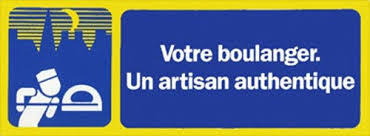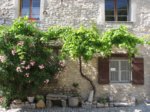Buying delicious bread at a genuine French bakery
Jos Deuling, Wednesday, 12 July 2017

In France, you can find a bakery on almost every street corner. They often offer a wide variety of different types of bread. For foreigners, this can be quite overwhelming. In this blog post, you’ll find an overview of various well-known and lesser-known types of bread. We also provide some tips, and at the bottom, you'll find a literature list and a few informative links.
How to find a good bakery?
In France, they often say that the closest bakery is the best one. But that's not always the case. Bakers who bake their bread on-site can call themselves a *Boulangerie*. These bakers often have a sticker on the shop window with the text Artisan Boulanger.

If you see this sticker, you know you're dealing with a real baker and not a *depot de pain* where frozen factory bread is reheated. Some *depots de pain* get their bread from a real boulangerie, but you would have to know that in advance. So, it's best to look for the sticker. However, you can also follow this rule: the best bakers are the ones with the longest line at the door.
French Bread Types
In the UK, when you think of French bread, you usually think of a baguette. But in France, bread comes in all shapes and sizes.
The baguette ordinaire is inexpensive, usually around one euro. They are often stacked like wood in the store, have a nice crispy crust, and are filled with light, airy white dough.
The baguette traditionnelle is a step up from the *ordinaire*. These are usually hand-kneaded, as you can tell from the pointed ends. This bread is slightly more expensive than the *baguette ordinaire*. Some bakers name their *baguette traditionnelle* after the neighborhood or bakery.
The flute (named after the wind instrument) can also be found in the UK. It is shaped like a baguette but larger. In some regions, it is thinner than a baguette and resembles a *ficelle*.
The ficelle (meaning "string") is a thin baguette, and the baguette aux céréales is a multigrain baguette.
A truly traditional French bread is the pain de campagne, also known as pain paysan. It has a thick crust, allowing it to stay fresh longer. *Pain de campagne* is a mix of whole wheat and white flour and is eaten with meat, cheese, soup, and stews.
Pain complet is whole wheat bread, pain de seigle is made from rye (though much lighter than English rye bread), and pain au levain is sourdough bread.
At boulangeries, you can also often find specialty breads with nuts, olives, or figs. Throughout France, there are also special regional breads.
Pastries
In France, pastries are called viennoiserie. It is believed that Queen Marie-Antoinette (originally from Vienna) introduced the croissant to France, hence the term viennoiserie. The pastries are made from light puff pastry, sometimes sweetened, and include eggs. In France, these pastries are often eaten for breakfast with butter, jam, Nutella, and a bowl of coffee.
The croissant and pain au chocolat are the most famous pastries. These are generally available in the UK as well.
The pain aux raisins contains raisins, and the chasson aux pommes is similar to an apple turnover.
Pain brioche is made from sweet dough with eggs. It's almost like cake.
Some practical tips
Many boulangeries are closed on Mondays. French shops must be closed at least one day a week. Many French bakers disagree with this, but they must follow the law.
If you like extra crispy bread (bien cuite) or bread with a soft crust (pas trop cuite), you can simply ask for it in the shop. This is quite normal in France.
The combination of bread and butter is only seen at breakfast in France. In a restaurant, bread is served without butter. You place the bread next to your plate on the tablecloth. After the meal, simply sweep the crumbs onto your plate.
Freshly baked baguettes harden quickly. However, you can still eat them the next day for breakfast by dipping them in a bowl of hot coffee or melted chocolate. You can also wrap the bread in a cloth overnight and toast it in the morning.

In France, you can find a bakery on almost every street corner. They often offer a wide variety of different types of bread. For foreigners, this can be quite overwhelming. In this blog post, you’ll find an overview of various well-known and lesser-known types of bread. We also provide some tips, and at the bottom, you'll find a literature list and a few informative links.
How to find a good bakery?
In France, they often say that the closest bakery is the best one. But that's not always the case. Bakers who bake their bread on-site can call themselves a *Boulangerie*. These bakers often have a sticker on the shop window with the text Artisan Boulanger.

If you see this sticker, you know you're dealing with a real baker and not a *depot de pain* where frozen factory bread is reheated. Some *depots de pain* get their bread from a real boulangerie, but you would have to know that in advance. So, it's best to look for the sticker. However, you can also follow this rule: the best bakers are the ones with the longest line at the door.
French Bread Types
In the UK, when you think of French bread, you usually think of a baguette. But in France, bread comes in all shapes and sizes.
The baguette ordinaire is inexpensive, usually around one euro. They are often stacked like wood in the store, have a nice crispy crust, and are filled with light, airy white dough.
The baguette traditionnelle is a step up from the *ordinaire*. These are usually hand-kneaded, as you can tell from the pointed ends. This bread is slightly more expensive than the *baguette ordinaire*. Some bakers name their *baguette traditionnelle* after the neighborhood or bakery.
The flute (named after the wind instrument) can also be found in the UK. It is shaped like a baguette but larger. In some regions, it is thinner than a baguette and resembles a *ficelle*.
The ficelle (meaning "string") is a thin baguette, and the baguette aux céréales is a multigrain baguette.
A truly traditional French bread is the pain de campagne, also known as pain paysan. It has a thick crust, allowing it to stay fresh longer. *Pain de campagne* is a mix of whole wheat and white flour and is eaten with meat, cheese, soup, and stews.
Pain complet is whole wheat bread, pain de seigle is made from rye (though much lighter than English rye bread), and pain au levain is sourdough bread.
At boulangeries, you can also often find specialty breads with nuts, olives, or figs. Throughout France, there are also special regional breads.
Pastries
In France, pastries are called viennoiserie. It is believed that Queen Marie-Antoinette (originally from Vienna) introduced the croissant to France, hence the term viennoiserie. The pastries are made from light puff pastry, sometimes sweetened, and include eggs. In France, these pastries are often eaten for breakfast with butter, jam, Nutella, and a bowl of coffee.
The croissant and pain au chocolat are the most famous pastries. These are generally available in the UK as well.
The pain aux raisins contains raisins, and the chasson aux pommes is similar to an apple turnover.
Pain brioche is made from sweet dough with eggs. It's almost like cake.
Some practical tips
Many boulangeries are closed on Mondays. French shops must be closed at least one day a week. Many French bakers disagree with this, but they must follow the law.
If you like extra crispy bread (bien cuite) or bread with a soft crust (pas trop cuite), you can simply ask for it in the shop. This is quite normal in France.
The combination of bread and butter is only seen at breakfast in France. In a restaurant, bread is served without butter. You place the bread next to your plate on the tablecloth. After the meal, simply sweep the crumbs onto your plate.
Freshly baked baguettes harden quickly. However, you can still eat them the next day for breakfast by dipping them in a bowl of hot coffee or melted chocolate. You can also wrap the bread in a cloth overnight and toast it in the morning.

Looking for a holiday home in France? Advertisements from private individuals and real estate agents throughout France. Fermettes and Gites in Burgundy, Aquitaine, Auvergne, and Lower Normandy.
 French people are quickly satisfied on holiday. A simple apartment in a busy seaside resort, as close to the sea as possible and close to the evening
entertainment, is sufficient. Usually, the apartment is rented well in advance and preferably through a friend of a friend.
The more affluent French people from large cities often have their own holiday home in the campagne, which is only two months a year + Christmas and
Easter in use, but with the whole family at the same time.
French people are quickly satisfied on holiday. A simple apartment in a busy seaside resort, as close to the sea as possible and close to the evening
entertainment, is sufficient. Usually, the apartment is rented well in advance and preferably through a friend of a friend.
The more affluent French people from large cities often have their own holiday home in the campagne, which is only two months a year + Christmas and
Easter in use, but with the whole family at the same time.